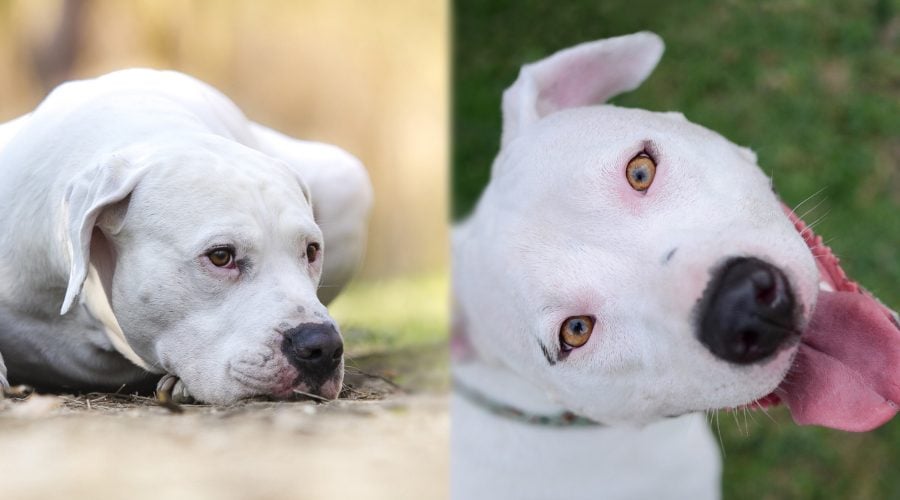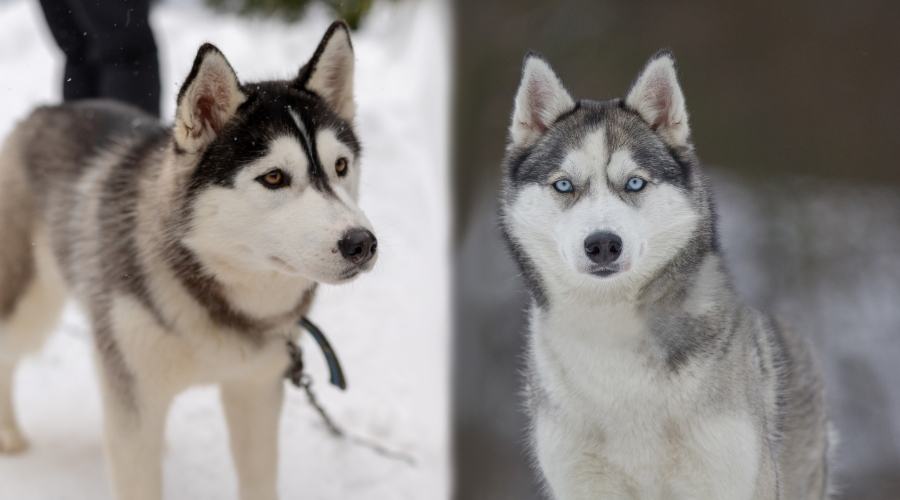German Spitz vs. Pomeranian: Breed Differences & Similarities
When you purchase through links on our site, we may earn a commission. Here’s how it works.
The German Spitz and the Pomeranian share the same ancestry. Descending from larger sled-pulling Arctic breeds, they date back almost 6,000 years, and their history has been intertwined ever since.
Table of Contents
These guys originate from Germany, where they were both traditionally used as herding and watchdogs, and although they are now more commonly found in family homes, they still make for a great watchdog with their piercing barking.
At a quick glance, the German Spitz and the Pomeranian are similar-looking pups. However, upon closer inspection, they are quite different in appearance. Their temperament is very similar, as are most of the other factors surrounding them both. Let’s take a closer look at what those differences are and get into the finer details.
If you are not certain of your dog’s genetic makeup, you can use an at-home DNA test kit to find out.
Breed Comparison
- Height12-15 Inches
- Height6-7 Inches
- Weight24-26 Pounds
- Weight3-7 Pounds
- TemperamentDevoted, Lively, Attentive
- TemperamentInquisitive, Bold, Lively
- EnergyAverage
- EnergyAverage
- HealthAverage
- HealthAverage
- Lifespan13-15 Years
- Lifespan12-16 Years
- Price$800 and Up
- Price$1,000 and Up
Key Differences
- The German Spitz is much larger, reaching 24 to 26 pounds.
- The Pomeranian is much smaller, reaching just 3 to 7 pounds.
- The German Spitz has a curly tail, and the Pomeranian has a plumed curvy tail.
- A Pomeranian has a longer life span, 16 years, vs. the German Spitz, which lives around 15.
- The German Spitz is less expensive.
Breed History
The word ‘Spitz’ is an umbrella term used to describe many breeds of dogs that are stocky with heavy coats, who have erect ears, and usually a pluming tail that carries up their back. Pomeranian is a direct descendant or even just a ‘toy’ version of the German Spitz, and as such, their history is closely entwined.
German Spitz
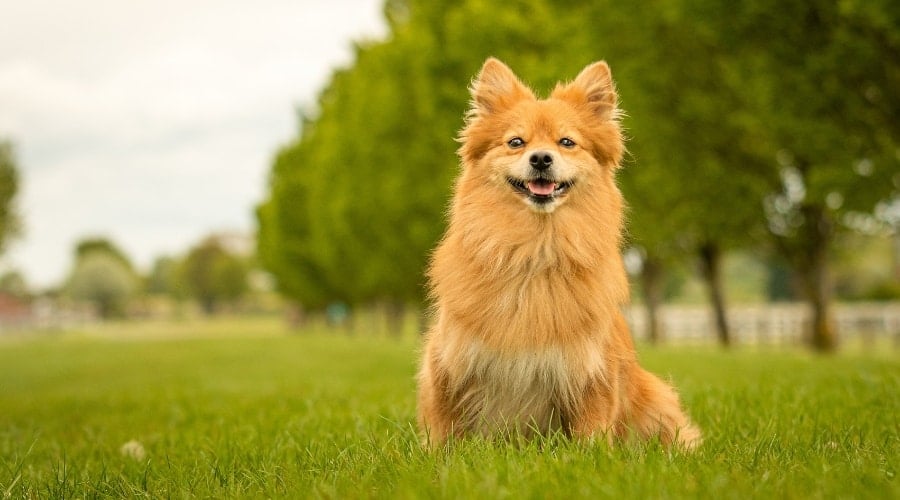
The German Spitz was first documented in the 15th Century in the area of Pomerania, and there they were used as farming watchdogs by the poorer members of society. It was in the 18th Century that his popularity boomed thanks to visiting royal nobles who took a fancy to him. George I, King of England during the 18th Century, had a German wife who was a big fan of the breed, as were all of her visiting friends who also brought their Spitz’s with them too.
It is important to note that there are officially five types of German Spitz breeds:
- Wolfspitz / Keeshond
- Grossespitz / Giant
- Mittel Spitz / Medium
- Klein Spitz / Miniature
- Toy Spitz / Pomeranian
In this article, we will be referring to the Mittel Spitz, or the medium-sized Spitz, as this is what most people think of when they are referring to a German Spitz. The German Spitz population suffered a massive decline in numbers after World War I, but by breeding the Keeshond with the Pomeranian, fanciers revived the Mittel’s numbers once again.
The German Spitz is a relatively new breed to America, and as such, he is currently in the Foundation Stock Service Program, which allows rarer breeds to establish fully recognizable status within the American Kennel Club (AKC). Because of this, he does not have a popularity rating compared with the Pomeranian and is much rarer in America.
Additionally, the AKC, the United Kennel Club, and the Canadian Kennel Club are the only major clubs in the world that recognize the American Eskimo Dog as a separate breed. Many other kennel clubs see him as the same German Spitz breed.
Some believe that this separation was due to anti-German sentiment and the renaming of many German breeds. If you like the German Spitz, be sure to check him out too, as they are also remarkably similar, if not the same, but that is a discussion for another day.
Pomeranian
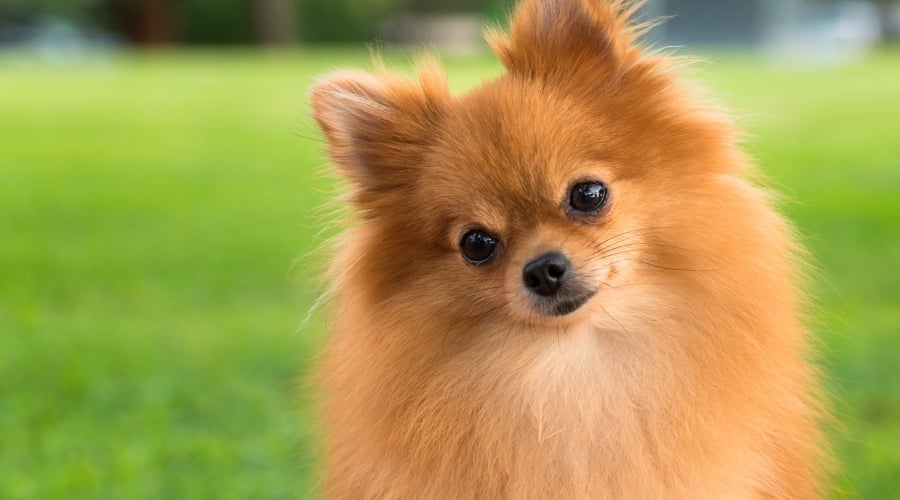
The Pomeranian’s name was taken from the province in Germany in which they were popular. It is believed that famous individuals, such as Michaelangelo, favored the smallest Spitz dogs, and Isaac Newton had a Pomeranian who is said to have eaten many of his manuscripts.
Just like the German Spitz, the Pomeranian became popular in the 18th Century with English Royalty, but the Pomeranians back then were much bigger and not as popular with the masses. This changed when Queen Victoria I stumbled across a 12-pound Pomeranian in Italy. It then became her life-long pastime to create much smaller Pomeranians, and eventually, he was refined to the size that we know today.
Since then, the Pomeranian, with his smaller toy stature, became an instant hit across the world, and the first Pomeranian to be entered into the AKC was in 1888. He is currently ranked as the 23rd most popular breed in America. The Pomeranian is also known as the Zwergspitz in many European countries.
Appearance
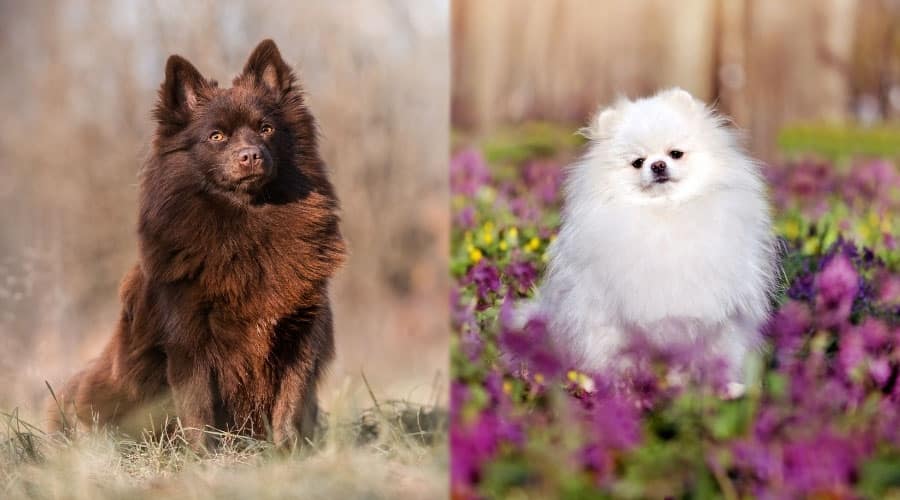
The German Spitz and the Pomeranian are small-sized pups, with the Pomeranian being the toy version. A German Spitz measures 12 to 15 inches from paw to shoulder in both males and females, whereas the Pomeranian measures only 6 to 7 inches, again in both males and females.
The German Spitz will weigh 24 to 26 pounds, whereas the Pomeranian will weigh a tiny 3 to 7 pounds. Again, both weights are the same for both males and females in both breeds. As you can see from the numbers, the German Spitz can be up to two times taller and weigh up to three times more than the Pomeranian. Both are good sized pups for apartments and smaller homes.
After the significant size difference, the second biggest difference between them is their coat. They both have double coats, which enabled them to keep warm while watching their herds and farms in Germany. However, the German Spitz’s undercoat is soft and fluffy, and his outer coat is coarser and straighter. Whereas the Pomeranian’s undercoat is short and dense, with his outer coat being finer longer fur, which gives him his fuzzball appearance, more so than the German Spitz.
If you were to wet the fur of both the German Spitz and the Pomeranian, you would see just how much bigger the German Spitz is compared to the Pomeranian. Poms come in many different colors, including black.
The German Spitz’s tail slightly curls to one side, whereas the Pomeranian has a heavily plumed tail that is set high and sits flat against his back. The Pomeranian has 18 standard colors that are recognized, whereas the German Spitz has just 8 recognized colors.
They also have different-shaped heads and muzzles. The German Spitz has a much longer muzzle that is 1/2 of his skull, whereas the Pomeranian has a much shorter muzzle that is 1/3 of his skull. The German Spitz’s ears are triangle-shaped and are erect and always visible, compared to the Pomeranian’s, which are also erect, but they often disappear in his fluffy mane.
Full details of the German Spitz’s breed standards are listed by the Federation Cynologique Internationale, and the Pomeranian’s breed standards are listed by the AKC.
Temperament
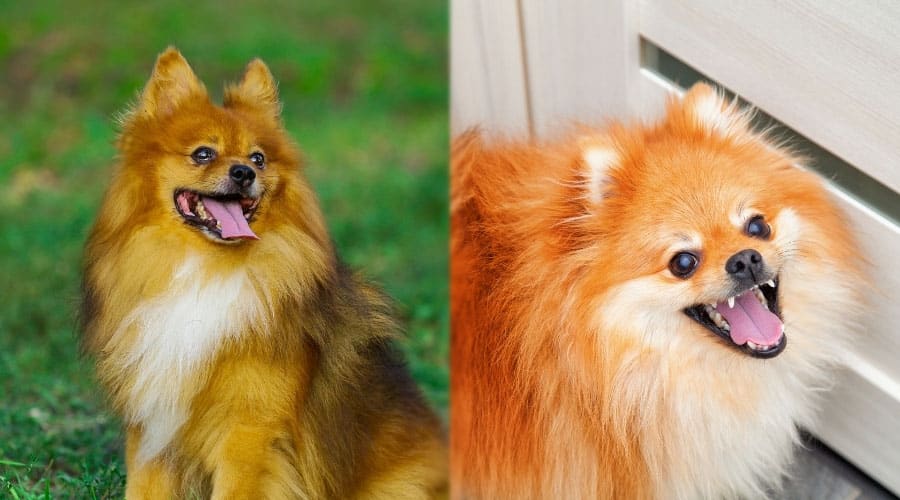
Despite their differing appearances, they have similar temperaments. They are both little pocket rockets who are lively and bouncy for hours on end. They are constantly on the go, and because of this, you need to be with them for most of the day, either entertaining them or having a cuddle. If you do have to leave them for extended periods of time, then it is imperative that you leave them with something to do. Their little legs might not need the exercise, but their brain rarely stops to rest.
They are both very sociable and inquisitive dogs who will want to be friends with everyone. Both are very affectionate with their family and will love to spend the afternoon napping on your lap. They also enjoy the company of children, but due to both the German Spitz and the Pomeranian’s small size, it is imperative to teach them how to handle a small dog properly because they are a lot more delicate than children think.
Because of their watchdog past, they are very barky, and they have definitely not lost this trait. This is great if you are after a cute canine that will alert you to everything, but if you aren’t that tolerant of barking or you live somewhere with noise restrictions, then neither of these guys is for you. For this reason, while they are generally happy with other dogs, their response will either be to yap because they are excited, or they will yap because they are challenging their fellow comrades. Their fearless challenges are often what causes them to be injured by other dogs who aren’t familiar with these little guys getting in their faces.
Exercise
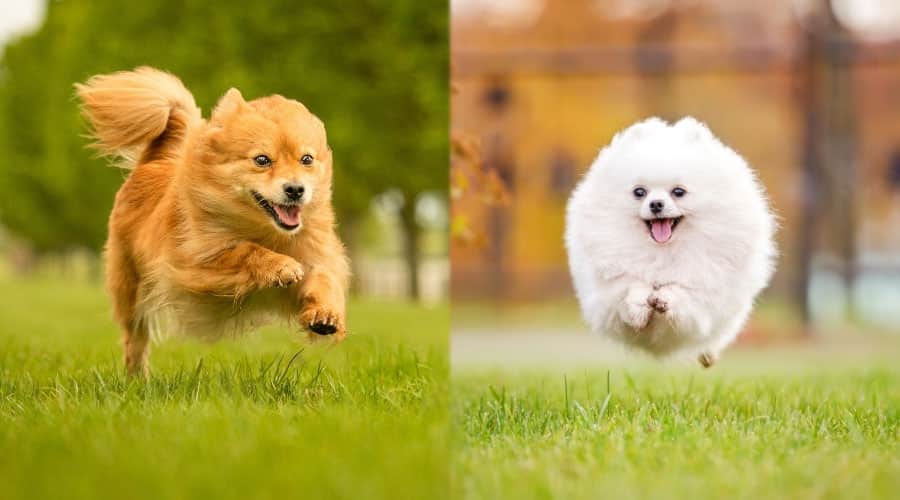
Both the German Spitz and the Pomeranian are firecrackers. Just like Tigger from Winnie the Pooh, they bounce all day long. They are considered to be medium-energy dogs and need up to 30 minutes of active exercise a day. This can consist of two walks a day, as long as you are also entertaining them both throughout the day, or they can entertain themselves in the garden.
They both need a considerable amount of exercise for a small dog, so do not expect a lapdog out of these guys, for both can be quite the destructive devil if they want to be. Both breeds will need dog toys that are fit for their size, and this is especially true with the Pomeranian.
Training
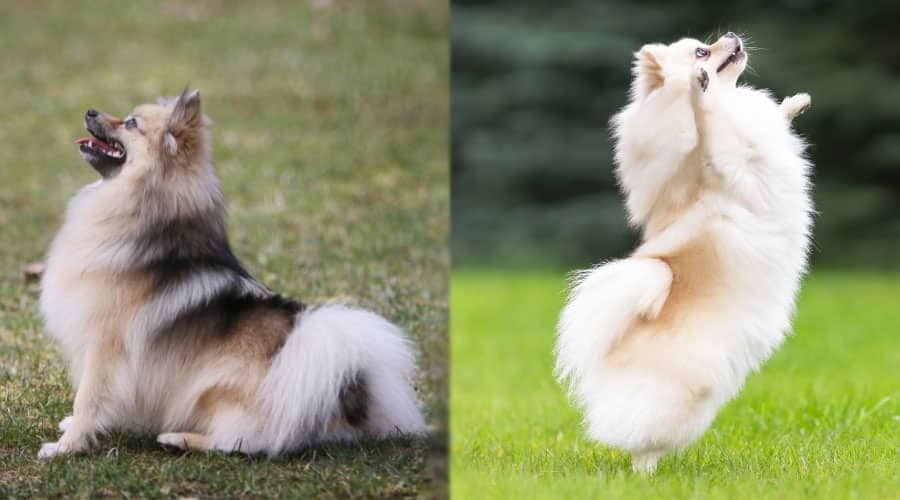
As with any dog, it is important to socialize with these guys as early as possible. Not only does this increase your chances of having a well-mannered adult pooch, but it also means that they are comfortable in many different situations. While they are not timid in any sense of the word, their small size often makes the world much larger and scarier, and socialization shapes them into the dogs that they should be; fearless and vivacious.
Although some view his high-pitched bark as cute, he should be trained to stop barking on command. Not only can it become tiresome after a while, but it also prevents him from picking fights with the bigger dogs, which will, in turn, prevent him from getting into any trouble. Be sure to read up on bark training with these little guys.
Health
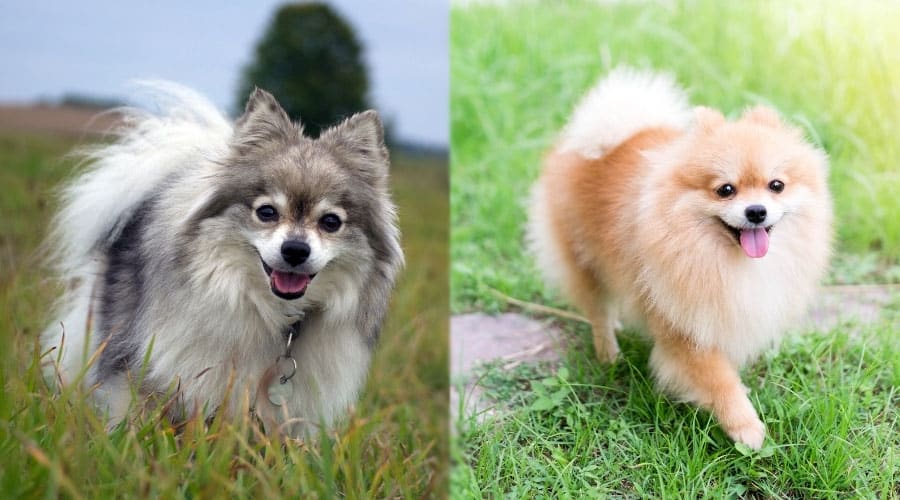
Both the German Spitz and the Pomeranian are generally healthy dogs with long lifespans. Because the German Spitz is a relatively new breed in America, there is little information to suggest exactly what tests are recommended for him, but as he suffers from similar health problems as the Pomeranian, it is a safe bet for his parents to have the same recommended health evaluations:
- Patella Evaluation
- Cardiac Exam
- Ophthalmologist Evaluation
The American Pomeranian Club has listed his health details in more detail on their website. Make sure to keep up with regular checkups and vaccinations for your pup, regardless of breed.
Could Pet Insurance Help?
If your pet insurance covers exam fees and your dog needs to be examined, there is a good chance your policy will reimburse those costs based on your policy details. However, if you are a new customer, vet expenses will not be covered until after your policy’s defined waiting periods, so signing up once you have an existing health concern is not going to help this time. Pre-existing conditions are not covered by any current pet insurance plans.
This is why it is a great idea to sign up for a pet insurance policy when your pet is young and relatively healthy to ensure you will be covered when you need it most.
Nutrition

The German Spitz will eat slightly more at around 2 cups of food a day, whereas the Pomeranian will eat around 1 to 1 1/2 cups a day. As with any dog, giving him top-quality kibble is the easiest way to enhance his health.
Grooming

Both the German Spitz and the Pomeranian need brushing every day to ensure that their hair is kept tangle-free, as well as assist in the management of shedding and fuzzy hair.
Neither of them needs to be bathed regularly, just so long as it is not more than once every 6 weeks. You should bathe them when they need general sprucing up or smell bad.
Dental cleaning should be made a priority with these small guys, as their small jaws increase their chances of experiencing dental health problems. Brushing them several times a week will be adequate.
Puppy Price

With the German Spitz being quite rare in America, there is little demand for them compared to the Pomeranian. While there is little information on the price of a German Spitz, it would appear that the average is $800+, which is much less compared to the cost of a Pomeranian, which is anywhere between $1,000 and $3,000.
Final Thoughts
The German Spitz and the Pomeranian are similar in their feisty and life-loving temperament, and despite appearing to look similar, they are quite different when you get down to the finer details. These guys are not your average small dog. They require moderate exercise and need specific training to ensure that they do not get too arrogant, so you must research them if you are considering welcoming one of these little guys into your home.
They share ancestry and history, and as such, their similar traits almost go hand in hand. Whatever their differences, they are both adorable small fluff balls that are full of energy and fun. So, if it’s a small dog with a big character that you are after, then these guys are exactly that!


